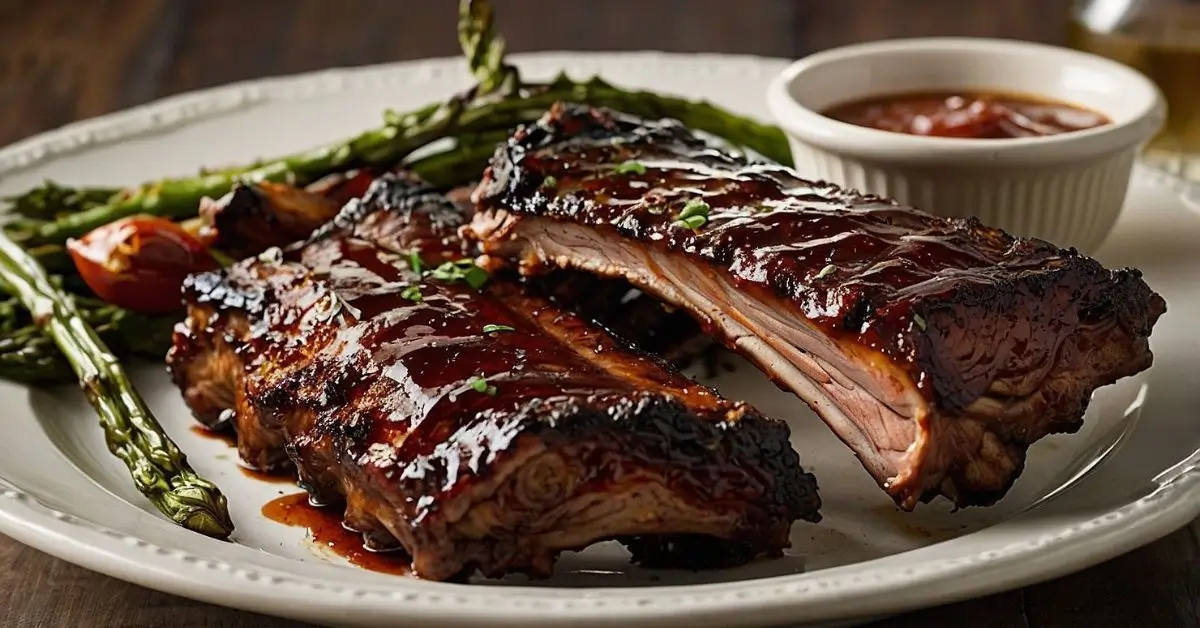Ribs are a quintessential comfort food, whether you’re enjoying them fresh off the grill or savoring the leftovers from a smoky barbecue feast. However, reheating ribs without drying them out or compromising the original flavor can be a bit tricky. In this guide, we’ll dive deep into various methods to reheat ribs while maintaining their tender texture and mouth-watering taste.
Why Reheating Ribs Properly is Important
Ribs are naturally juicy and flavorful when freshly cooked, but improper reheating can result in dry, tough meat. Ribs, whether pork, beef, or lamb, have a natural balance of fat and muscle fibers that require careful attention during reheating to maintain their moisture and flavor. Using the wrong technique can cause the ribs to lose their tenderness and become chewy or even burnt.
When reheating, it’s crucial to think about two factors:
- Moisture Retention: Ribs need to stay moist during reheating to ensure the meat remains tender.
- Flavor Preservation: The smoky, spicy, or tangy flavors that ribs typically have should be preserved rather than dulled by improper reheating.
Now that we understand the importance of preserving moisture and flavor, let’s explore the best methods to reheat ribs.
Reheating Ribs in the Oven
Why Use the Oven?
The oven is one of the most popular methods for reheating ribs because it offers consistent heat and allows for moisture retention. Oven reheating works well for both dry-rubbed and sauce-coated ribs, ensuring that the meat heats evenly without overcooking or drying out.
Step-by-Step Process:
- Preheat the Oven: Set your oven to 250°F (120°C). This low temperature ensures that the ribs heat slowly, helping preserve their juiciness and texture.
- Prepare the Ribs: Take the ribs out of the refrigerator and allow them to come to room temperature. This step helps them reheat more evenly.
- Moisture Retention: To keep the ribs moist, wrap them in aluminum foil. If you’re reheating ribs with a sauce, you can add a splash of water, broth, or barbecue sauce before sealing the foil. This will create steam inside the foil, locking in moisture.
- Reheat the Ribs: Place the wrapped ribs on a baking sheet and place them in the preheated oven. For best results, reheat for about 30-45 minutes. The exact time will depend on the thickness of the ribs and how cold they were before reheating.
- Check for Doneness: After 30 minutes, carefully open the foil and check the ribs. You want them to be heated through, but not dried out. If they need more time, reseal the foil and continue heating in 5-10 minute increments.
- Optional Finishing Touch: If you like a bit of crispiness, you can remove the ribs from the foil in the last 5-10 minutes of reheating and broil them for a minute or two. Be careful not to leave them under the broiler too long, as they can burn quickly.
Pros and Cons of Reheating Ribs in the Oven
- Pros:
- Retains moisture with foil wrapping.
- Even heating across the ribs.
- Great for both saucy and dry-rubbed ribs.
- Cons:
- Takes more time compared to other methods.
- Requires more hands-on preparation.
Reheating Ribs on the Grill
Why Use the Grill?
Reheating ribs on the grill is perfect for maintaining that smoky, grilled flavor. It’s especially effective if you’re a fan of the crispy outer layer that comes from direct heat. However, this method requires a bit more attention to prevent overcooking or burning.
Step-by-Step Process:
- Preheat the Grill: Set your grill to medium heat (around 250-300°F or 120-150°C). If possible, create two heating zones – one for direct heat and one for indirect heat. This will give you more control over the reheating process.
- Prepare the Ribs: If your ribs have been in the fridge, let them sit out for 10-15 minutes to come to room temperature. This ensures even heating.
- Wrap the Ribs (Optional): You can wrap the ribs in aluminum foil if you want to retain more moisture, similar to the oven method. However, if you prefer a crispy, grilled finish, skip the foil.
- Reheat the Ribs: Place the ribs on the grill over the indirect heat zone, keeping the lid closed to create an oven-like environment. Reheat for 10-15 minutes per side. If you’re using foil, let them heat for 20-30 minutes in total.
- Finishing Touch: For extra crispiness or caramelization, move the ribs to the direct heat zone for a minute or two on each side, but be careful not to burn them.
- Sauce Them Up: If you’re using a barbecue sauce, apply it during the last few minutes of reheating. This prevents the sugars in the sauce from burning while still giving the ribs a flavorful glaze.
Pros and Cons of Reheating Ribs on the Grill
- Pros:
- Adds a smoky flavor and crispy texture.
- Quick compared to the oven method.
- Great for outdoor cooking or summer meals.
- Cons:
- Requires more attention to prevent burning.
- Can dry out the ribs if not monitored closely.
Reheating Ribs in the Microwave
Why Use the Microwave?
The microwave is the fastest way to reheat ribs, making it a good option when you’re in a hurry. However, this method is more likely to dry out the ribs, so it’s best used for small portions or in combination with other methods.
Step-by-Step Process:
- Prepare the Ribs: Place the ribs in a microwave-safe dish. To help retain moisture, you can add a bit of water or broth to the bottom of the dish. Cover the ribs with a damp paper towel or microwave-safe lid to trap steam.
- Reheat the Ribs: Heat the ribs on medium power (50-70%) for 2-3 minutes. After this, check the ribs to see if they are heated through. If not, continue heating in 30-second increments until they reach the desired temperature.
- Avoid Overcooking: Be mindful of reheating too long, as microwaves can quickly dry out the meat. If you find the ribs are drying out, add more moisture (such as broth or barbecue sauce) and reheat for shorter intervals.
Pros and Cons of Reheating Ribs in the Microwave
- Pros:
- Fast and convenient.
- Ideal for small portions or quick meals.
- Cons:
- More likely to dry out ribs.
- Uneven heating if not careful.
- Doesn’t retain the same texture as other methods.
Reheating Ribs in a Sous Vide
Why Use Sous Vide?
Sous vide is a technique where food is vacuum-sealed and cooked in a water bath at a precise temperature. This method is excellent for reheating ribs because it ensures even heating while locking in moisture and flavor. Though it requires special equipment, sous vide is one of the best ways to preserve the quality of ribs when reheating.
Step-by-Step Process:
- Set Up the Sous Vide: Preheat the water bath to 165°F (74°C), the ideal temperature for reheating ribs without overcooking.
- Vacuum Seal the Ribs: If your ribs aren’t already vacuum-sealed, place them in a plastic bag and vacuum-seal them. Make sure the bag is airtight to prevent water from leaking in.
- Reheat the Ribs: Submerge the vacuum-sealed ribs in the water bath and let them reheat for 45-60 minutes. The low, consistent heat will ensure that the ribs are heated through without drying out.
- Finishing Touch (Optional): If you want a crispy exterior, you can finish the ribs on the grill or under the broiler for a few minutes after reheating.
Pros and Cons of Reheating Ribs with Sous Vide
- Pros:
- Excellent for moisture retention.
- Even heating without drying out the meat.
- Ideal for larger quantities or meal prep.
- Cons:
- Requires specialized equipment.
- Takes longer compared to other methods.
Reheating Ribs on the Stove
Why Use the Stove?
Using a stovetop is a quick and relatively simple method for reheating ribs. It works best for small portions, and with the right technique, you can retain both moisture and flavor. However, it’s not ideal for large portions or ribs that need a crispy texture.
Step-by-Step Process:
- Heat a Pan: Place a non-stick pan on the stove and heat it over medium heat. Add a tablespoon of oil or butter to prevent sticking.
- Add Liquid: Pour a small amount of water, broth, or barbecue sauce into the pan to help keep the ribs moist while reheating.
- Reheat the Ribs: Add the ribs to the pan and cover it with a lid. Let the ribs heat for about 5 minutes, then flip them and cook for another 5 minutes, adding more liquid if necessary to prevent drying out.
- Check for Doneness: Ensure the ribs are heated through by cutting into the thickest part of the meat.
Pros and Cons of Reheating Ribs on the Stove
- Pros:
- Quick and easy for small portions.
- Allows you to add
extra sauce or seasoning during reheating.
- Cons:
- Not ideal for large portions.
- Can dry out if not enough moisture is added.
Final Thoughts: The Best Way to Reheat Ribs
Each method of reheating ribs has its advantages and challenges, but the best approach depends on your personal preference and the time you have available. For maximum moisture retention and flavor preservation, the oven and sous vide methods stand out as top choices. If you want a crispy exterior and that grilled flavor, reheating on the grill is an excellent option. For convenience and speed, the microwave and stovetop methods are quick fixes but require extra care to avoid drying out the ribs.
Regardless of the method you choose, the key to successfully reheating ribs lies in maintaining moisture, controlling heat, and being mindful of timing. By following the tips in this guide, you can enjoy ribs that taste just as delicious as when they were first cooked!











